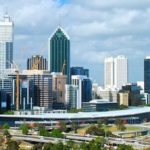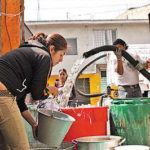This is the last in our ‘words matter’ series by Douglas Bartlett, Manager Asset Planning, City of Kalamunda, and member of the Perth City Chapter. Is this how you would interpret growth and prosperity for all? Doug welcomes your responses and alternatives.
 Growth is a concept based on natural systems and leads to efficient forms (such as living creatures). Aside from the biological growth, there is also the ability for an individual to grow in experiences, learning, and skills, which may or may not have limits. Growth in populations can be geometric and uncontrolled, limited by resources with ‘natural’ controls via food, space, reproduction rates, predators.
Growth is a concept based on natural systems and leads to efficient forms (such as living creatures). Aside from the biological growth, there is also the ability for an individual to grow in experiences, learning, and skills, which may or may not have limits. Growth in populations can be geometric and uncontrolled, limited by resources with ‘natural’ controls via food, space, reproduction rates, predators.
Using the context of the growth of the living creature, can we change the language or philosophy behind AM ‘Growth and Demand’ such that our community and its assets is considered to be a living organism which grows to create its most efficient form? This implies that the eventual form is matched to the limit in resources. This language would replace the mathematical population growth models, that are theoretically without limit. In our modelling of course, we must place a conceptual limit to growth because at some level we are unable to imagine the size of the population.

Mexico water shortage. Filling up from water trucks.
Prosperity can include concepts of equity, opportunity for a job, a business, to eat, learn, have shelter, recreate. Prosperity is a present state measure and is measured against historical states or other communities. There is no future focus so if we adopt ‘Prosperity’ as the objective:
- we may struggle or suffer from a lack of perspective of future impacts/threats, and
- we may not be able to react to change.
When considering the change of word from growth to prosperity we must also remember that AM looks at ‘Growth and Demand’ not just growth. ‘Demand’ introduces an economic perspective whereby the price increases until the demand and price are balanced within the marketplace. In terms of AM this means people will demand more (quantity, quality, time, less cost) until a point that the service exceeds their desire to pay for it. But in reality the point we try to each is where people become comfortable (with what they have) and no longer seek or expect more. Also the community is not directly exposed to the cost of things, as they pay taxes and receive services but there is almost no direct connection between them. So: we are trying to determine the demand for services, and demand is met once people become comfortable.
Putting these ideas together: growth in a living organism, ensuring we keep a future focus, and demand reaching a level of comfort: the service provided by assets needs to be modeled so that the service is expected to grow and change form, metamorphosing into a new service that is more efficient for the community: The new butterfly effect.
The third in our series on ‘words matter’ by Douglas Bartlett, Manager Asset Planning, City of Kalamunda. Do you agree? As usual, Doug welcomes your responses and alternatives.

Grenfell Tower Fire June 2017
Risk management, when taken to its root cause, is about the potential harm to an individual. But not just any individual, it is the harm to the person assessing the risk. We are all, by nature, selfish and will always assess and measure things against ourselves (no matter how gracious and service oriented we may be). If I assess the risk of a Bike Plan failing to deliver its outcomes, I can talk about how the community won’t get the health benefits or maybe safety improvements that it needs, but whether these things happen or not is irrelevant to me unless I (personally) can be affected by it. I can be affected by getting blamed for the failed outcomes, or by losing reputation. So the core perception of risk comes down to how the individual perceives the threat of harm.
Risks are ‘managed’ by introducing practices that are thought to decline the level of risk. Risks (in terms of AM planning) are typically recorded only for significant events, and treatments are also typically not analysed in detail. So the activity of risk management in AM may suffer from a lack of detail, and also may suffer from the assumption that management practices will manage the risk.
In my job, I am uncertain on a day to day basis. I am uncertain when I reply to a request for a new path, because I can’t be sure if the path is really needed. I am uncertain when a developer wants to discharge stormwater into the drain pipe, because despite the calculations and standards there are a huge number of assumptions being made. From an analytical and statistical perspective, I am uncertain most of the time.
So which term is more useful? In consideration of our selfish natures, is it more harmful to me to be uncertain or to try to manage risk? I am uncertain on a day to day basis and it does not appear to be causing me harm. By implication then I won’t try to change practices where they appear to be working (no matter how uncertain they may be). So, I think Risk is the better term as it will drive a reaction from the individual.
Continuing our blog post series by Douglas Bartlett, Manager Asset Planning, City of Kalamunda. Here he looks at how we might define and use the word ‘Adaptability’. Again, Doug welcomes your thoughts and alternatives.

‘sustainable’ but ‘adaptable’?
Sustainability is an undefined concept, but so is Adaptability. How do we describe what an adaptable asset is? Adaptability suggests that the service being provided by the assets will need to change
But are adaptable assets expected to last forever? Perhaps not at the component level but, through adaptability in the design, ensure the network or higher order asset will last forever? Roman roads in Italy are still being used today but in a current form different to their original form. It is difficult to think of examples of buildings (or other infrastructure) that have lasted a very long time, because the original designs would not have incorporated adaptability concepts. Those buildings that have lasted centuries or one to two thousand years have continued to be used for the same purpose as originally constructed (or converted to a tourist attraction which essentially involves keeping them unchanged).
Adaptability could be designed for reduced resource consumption, or perhaps greater resource consumption as an accepted offset for the higher level of adaptability (air conditioning in a larger room for example which enables the room to have more uses, but which increases overall energy load).
Perhaps the solution is not to change the word from sustainability to adaptability, but to instead drive greater levels of adaptability in the design and management of assets. This can be done by expanding what sustainable means with a fourth element. Sustainability for asset management means for a defined time period and service level:
1 The asset will last (provide its full function) for the time period
2 The service provided by the asset will last for the same defined time period (the service may be subject to change but this is not limited by the asset)
3 The asset and service will require no expenditure of resources beyond what is defined in the service (noting that resource consumption efficiency should be defined in the service), and
4 The asset is designed to be adaptable to a wider range of services, and also to the changing service needs over time.
Douglas Bartlett, Manager Asset Planning, City of Kalamunda, and a member of the Perth City Chapter is our blog poster for the next four posts. Here he looks at how we might define sustainability. Do you agree? Doug welcomes your responses
 In considering what ‘sustainable asset management’ means we first need to recognise that ‘sustainable’ is poorly understood. It implies a quasi-positive future benefit but is usually not defined. How else can we express ourselves if not using the word sustainable?
In considering what ‘sustainable asset management’ means we first need to recognise that ‘sustainable’ is poorly understood. It implies a quasi-positive future benefit but is usually not defined. How else can we express ourselves if not using the word sustainable?
Thomas Rau of Turntoo (http://turntoo.com/en/) is a designer, architect and thinker who is exploring a wider view of the selection and use of materials for buildings (or for any purpose). The idea is that every piece of material should be used, as long as possible, and then used again, not recycled. This includes practices such as:
- Having the United Nations adopt a Declaration of Materials Rights that prevents throwing anything out,
- Reusing existing old buildings by giving them new functions and extensions,
- Deliberately taking the building materials and parts (bricks, windows) and reusing them, but also ensuring their original design is to be reused without generating waste, and
- Asking for light, not lights. This means it becomes the supplier’s responsibility to supply the specified level of lighting for say 15 years. The supplier wears the costs of any failures so is pushed to manufacture lights that last the longest and require the least maintenance.
We could define a sustainable asset as being an asset that lasts forever and provides its service forever, with no net expenditure of energy (resources). But nothing lasts forever, so a sustainability statement is needed that defines sustainability in terms of time and resources, while continuing to provide the specified service (Lighting is sustainable if provided at the specified level, for 15 years, at agreed cost, where cost represents the energy consumption and any waste at end of life). Perhaps our asset management plans should include a definition of sustainability in terms of the assets in this manner.

Recent Comments